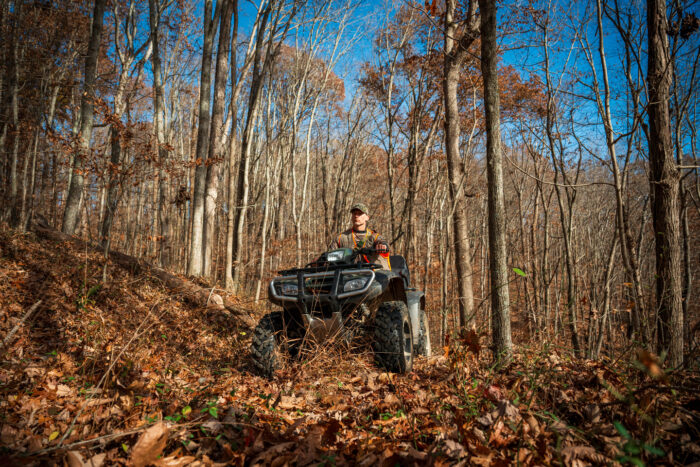Scouting and safety checks prepare hunters for a successful and safe season
With hunting seasons already underway and more set to open later in October and November, it’s the perfect time to ensure you’re fully prepared for your fall hunting adventures. Before you step into the woods, take a few extra moments to fine-tune your plans and gear. Scouting your hunting locations, checking your equipment and brushing up on safety practices don’t just boost your chances for a successful harvest—they ensure you return home safely at the end of the day. Here are five essential tips to help you get ready.

Scout Your Location
Pre-season scouting is a critical step in increasing your odds of successfully harvesting game. Whether you’re hunting public or private land, understanding the topography, mast conditions and general habitat of the area can make a big difference. Knowing the lay of the land also helps you predict where wildlife will travel and find cover. The best way to scout a location is to visit before your hunt, but you can also survey an area using our online hunting map.
In addition to identifying key terrain features, pay attention to food sources like acorns, hickory and beech trees. These hard mast producers are magnets for deer, bear and squirrel during the fall. Also, take note of any recent changes to the landscape, such as new clearings or logged areas, as these can alter game movement patterns. Finally, consider setting up trail cameras to monitor wildlife activity and adjust your hunting plans accordingly.

Check Your Hunting Gear
Before you head out, it’s crucial to check all your hunting gear, not just your weapon. A well-prepared hunter is a safe and successful hunter, so take the time to ensure everything is in proper working order.
Start with your clothing. Inspect your camouflage for any rips or tears and check that your boots are waterproof and comfortable. Pack essentials like a first aid kit, a map or GPS and extra batteries for your flashlight or headlamp. Don’t forget to test your backpack’s zippers and straps to avoid any surprises in the field. Lastly, make sure your hunting license, tags and any other necessary information are easily accessible.

Practice Your Shot
Whether you use a bow, crossbow, rifle or muzzleloader, practicing your shot well before the season starts is essential. When practicing, always use the same arrows, bolts or ammunition that you plan to hunt with, as changes in weight or grain can drastically affect your accuracy.
Practicing ahead of time also allows you to check if your sights were bumped or shifted during storage. For bow and crossbow hunters, inspect your strings for fraying and the arms for cracks—these issues can cause serious harm if they fail during a draw. Additionally, ensure your broadheads are sharp to facilitate a quick, ethical kill.
Along with sharpening your skills, it’s crucial to follow the 10 rules of firearm safety every time you handle your weapon to ensure a safe and ethical hunt.
- Point the muzzle in a safe direction at all times.
- Treat every firearm as if it’s loaded, even if you think it isn’t.
- Know your target, what’s in front, and what’s beyond it. Ensure a safe backstop.
- Keep your finger off the trigger until you’re ready to shoot.
- Check the barrel and action for obstructions and use the correct ammunition.
- Unload firearms when not in use and leave actions open.
- Only point at what you intend to shoot. Never engage in horseplay.
- Don’t run, jump or climb with a loaded firearm. Unload before crossing obstacles.
- Store firearms and ammunition separately in secure locations.
- Avoid alcohol and drugs before and during shooting.

Tree Stand Safety
If you plan to hunt from a tree stand, taking the time to ensure your equipment is in good condition is crucial for your safety. Start by inspecting all straps and fasteners, replacing any that show signs of wear or fraying. Check the stand’s stability by setting it up in a controlled environment before heading into the field.
Your safety harness is one of the most important pieces of gear you’ll use. Always wear it when you’re in your tree stand, as well as when you’re climbing up or down. Falls are one of the leading causes of hunting-related injuries, and a harness can be the difference between a close call and a tragic accident. Additionally, practice using your harness and stand in a safe environment to ensure you’re comfortable and confident with your setup.

Review Hunting Regulations
A final and important thing to do when preparing for hunting season is to know the regulations. Understanding and following hunting regulations isn’t just a legal requirement—it’s essential for safety and wildlife conservation. Regulations are designed to ensure that hunting is conducted ethically and sustainably, protecting game species and their habitats for future generations.
Take the time to review the most current regulations, which you can access for free at WVDNR district offices, license vendors or online at WVdnr.gov/hunting-regulations. Be aware of any changes to season dates, bag limits, and hunting zones, as these can vary year to year. If you’re unsure about any rules, don’t hesitate to contact your local WVDNR district office and a representative will help you with your questions.
Buy Your License and Stamps Today
If you still need to purchase a 2024 hunting license and stamps, make sure you buy them before your preferred season opens to make sure you don’t miss a minute of action. While you’re at it, elevate your hunting experience by opting to purchase one of our new durable license cards. Get your license and stamps today at WVhunt.com.




